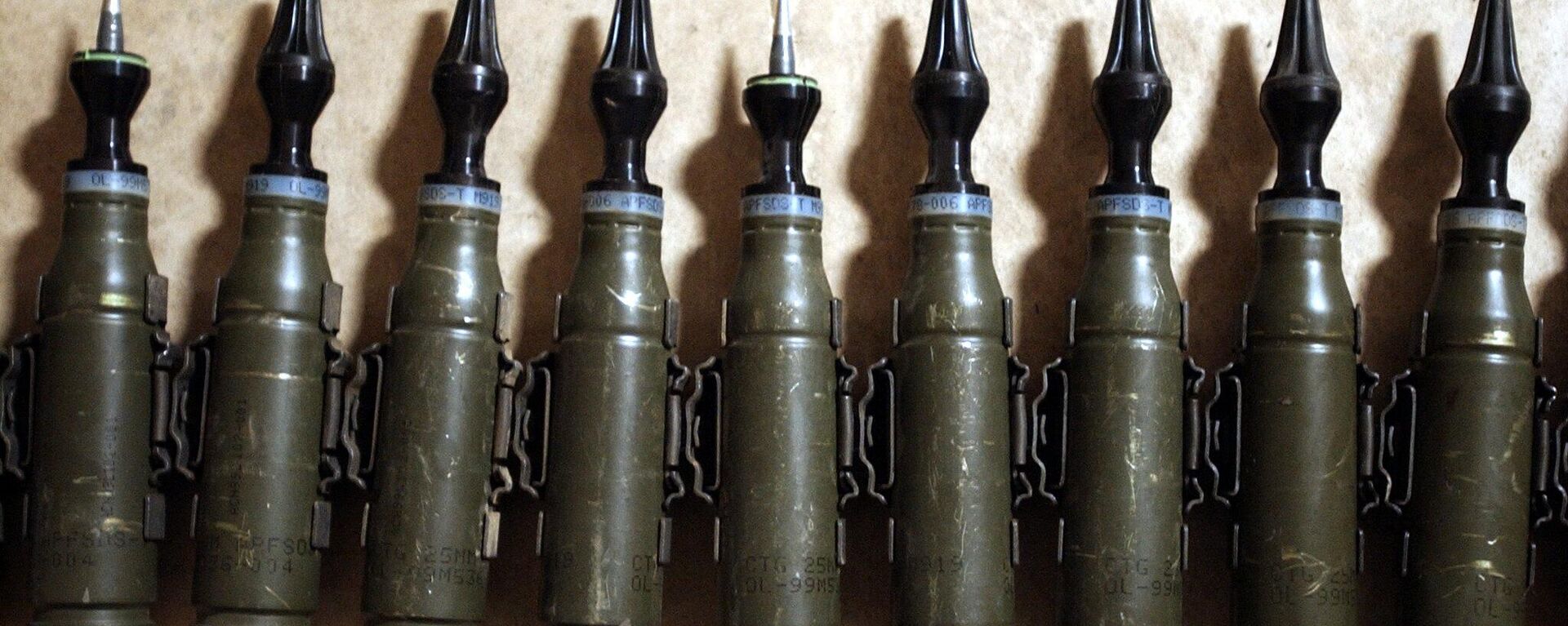https://sputnikglobe.com/20230322/why-is-britains-uranium-ammo-decision-a-big-deal-1108699845.html
Why is Britain’s Uranium Ammo Decision a Big Deal?
Why is Britain’s Uranium Ammo Decision a Big Deal?
Sputnik International
That Russia has taken a principled stand about the use of DU as a weapon underscores the fact that its stance regarding the introduction of DU into Ukraine by the UK is not merely a political show, but a national security reality.
2023-03-22T18:13+0000
2023-03-22T18:13+0000
2023-05-28T15:26+0000
russia's special operation in ukraine
ukraine
columnists
russia
depleted uranium
united kingdom (uk)
https://cdn1.img.sputnikglobe.com/img/07e7/03/16/1108700869_0:98:1001:661_1920x0_80_0_0_e5d05e701009772f619f2e8db9e9bc4e.jpg
According to the British MoD, depleted uranium, or DU, “is a standard component and has nothing to do with nuclear weapons,” adding that “The British Army has used DU in its armor piercing shells for decades," the statement added. Moreover, the ministry stated, “Independent research by scientists from groups such as the Royal Society has assessed that any impact to personal health and the environment from the use of depleted uranium munitions is likely to be low,” declaring that “Russia knows this.”For its part, Russia—which has always opposed the introduction of any uranium-derived weapons into the Ukraine conflict, responded with harsh words of censure and warning. “If all this happens,” Russian President Vladimir Putin said, “Russia will have to respond accordingly, given that the west collectively is already beginning to use weapons with a nuclear component.” The Russian Minister of Defense, Sergei Shoigu, likewise noted that, thanks to the British actions, there were now fewer steps left before a potential “nuclear collision” between Russia and the west.The toxicity of depleted uranium ammunition used on the battlefield remains an issue of some dispute. In 1999, NATO fired some 30,000 rounds of depleted uranium munitions in Kosovo as part of the military intervention in Kosovo (KFOR). According to Lt. Col Alexander Willing, a KFOR spokesman, “NATO’s use of DU in the Kosovo conflict did not cause any continuing health risk and therefore no further action was required on our part,” he wrote.The KFOR/NATO position is backed up by an assessment conducted by the International Atomic Energy Agency, which concluded that “There was no detectable, widespread contamination of the ground surface by depleted uranium. This means that any widespread contamination is present in such low levels that it cannot be detected or differentiated from the natural uranium concentration found in rocks and soil. The corresponding radiological and toxicological risks are insignificant and even non-existent.”The KFOR/NATO/IAEA reports, however, were contradicted by a study published by the National Institute of Health regarding an increase in hematological malignancies (HM) in Kosovo that appear to be linked with DU exposure. This report stated that the “incidence of HM increased by 3.19/100,000 persons (82%)” in regions where the use of DU ammunition was high.“Despite these findings,” the report concluded, “this study warrants further investigation and does not lead us to a conclusive finding on the existence of a causal relationship between the use of DU during the war and the rise in incidence of HM in Kosovo.”The same cannot be said about the use of DU munitions by the United States in Iraq. Human Rights Now (HRN), a Japan-based non-governmental organization, performed an independent analysis of the impact DU had on the civilian population of the city of Fallujah, the scene of heavy combat involving US forces who employed DU munitions. According to the HRN report, “an extraordinary situation of congenital birth defects” were detected “in both nature and quantity. The report concluded that the presence of DU in the environment resulting from combat “may be playing a significant role in the observed rate of birth defects.”The US military itself points to the potential health hazard posed by exposure to DU. says depleted uranium ammunition is safe, for the most part. “When fired, or after ‘cooking off’ in fires or explosions, the exposed depleted uranium rod poses an extremely low radiological threat as long as it remains outside the body,” the US Military Health Agency notes. “Taken into the body via metal fragments or dust-like particles, depleted uranium may pose a long-term health hazard to personnel if the amount is large. However, the amount which remains in the body depends on a number of factors, including the amount inhaled or ingested, the particle size and the ability of the particles to dissolve in body fluids.”There has been some effort by the Western media to paint Russia as somewhat hypocritical in its approach to the use of depleted uranium in its own anti-tank ammunition. While the Soviet Army did, in fact, make use of depleted uranium penetrators in certain types of anti-tank ammunition, it has been the practice of the Russian Army to remove these weapons from its inventory, something that was accomplished in the early 2000’s. However, some media outlets have published claims that the new Svinets-2 (3BM-60) round, employed on the new T-90 tank, uses a DU penetrator.This is apparently a false claim. According to Rybar, an online analytical service, “the Svinets-2 has a tungsten alloy core that, together with the 4Zh96 Ozon-T charge, provides about 700 mm (27 in) of right-angle penetration through solid steel at 2 km. The projectile's 740-mm length allows it to be used only in newer T-90A, T-90M, T72B3 and T80BVM tanks.”That Russia has taken a principled stand about the use of DU as a weapon underscores the fact that its stance regarding the introduction of DU into Ukraine by the UK is not merely a political show, but a national security reality, and that Russian warning regarding the consequences of such actions should be treated with all seriousness.
https://sputnikglobe.com/20230322/what-are-depleted-uranium-shells-and-how-hazardous-are-they-1108685054.html
ukraine
russia
united kingdom (uk)
Sputnik International
feedback@sputniknews.com
+74956456601
MIA „Rossiya Segodnya“
2023
Scott Ritter
https://cdn1.img.sputnikglobe.com/img/07e6/0c/17/1105733958_0:0:334:334_100x100_80_0_0_b457e4e9c850ef224b0cc79059bb38df.jpg
Scott Ritter
https://cdn1.img.sputnikglobe.com/img/07e6/0c/17/1105733958_0:0:334:334_100x100_80_0_0_b457e4e9c850ef224b0cc79059bb38df.jpg
News
en_EN
Sputnik International
feedback@sputniknews.com
+74956456601
MIA „Rossiya Segodnya“
Sputnik International
feedback@sputniknews.com
+74956456601
MIA „Rossiya Segodnya“
Scott Ritter
https://cdn1.img.sputnikglobe.com/img/07e6/0c/17/1105733958_0:0:334:334_100x100_80_0_0_b457e4e9c850ef224b0cc79059bb38df.jpg
depleted uranium shells ukraine, depleted uranium shells, depleted uranium ammunition effects
depleted uranium shells ukraine, depleted uranium shells, depleted uranium ammunition effects
Why is Britain’s Uranium Ammo Decision a Big Deal?
18:13 GMT 22.03.2023 (Updated: 15:26 GMT 28.05.2023) The United Kingdom Ministry of Defense announced that it would be sending anti-tank ammunition for the Challenger 2 tanks being delivered to Ukraine that contain depleted uranium.
According to the British MoD, depleted uranium, or DU, “is a standard component and
has nothing to do with nuclear weapons,” adding that “The British Army has used DU in its armor piercing shells for decades," the statement added. Moreover, the ministry stated, “Independent research by scientists from groups such as the Royal Society has assessed that any impact to personal health and the environment from the use of depleted uranium munitions is likely to be low,” declaring that “Russia knows this.”
For its part, Russia—which has always opposed the introduction of any uranium-derived weapons into the Ukraine conflict, responded with harsh words of censure and warning. “If all this happens,” Russian President Vladimir Putin said, “
Russia will have to respond accordingly, given that the west collectively is already beginning to use weapons with a nuclear component.” The Russian Minister of Defense, Sergei Shoigu, likewise noted that, thanks to the British actions, there were now fewer steps left before a potential “nuclear collision” between Russia and the west.
The
toxicity of depleted uranium ammunition used on the battlefield remains an issue of some dispute. In 1999, NATO fired some 30,000 rounds of depleted uranium munitions in Kosovo as part of the military intervention in Kosovo (KFOR).
According to Lt. Col Alexander Willing, a KFOR spokesman, “NATO’s use of DU in the Kosovo conflict did not cause any continuing health risk and therefore no further action was required on our part,” he wrote.
The KFOR/NATO position is backed up by
an assessment conducted by the International Atomic Energy Agency, which concluded that “There was no detectable, widespread contamination of the ground surface by depleted uranium. This means that any widespread contamination is present in such low levels that it cannot be detected or differentiated from the natural uranium concentration found in rocks and soil. The corresponding radiological and toxicological risks are insignificant and even non-existent.”
The KFOR/NATO/IAEA reports, however, were contradicted by
a study published by the National Institute of Health regarding an increase in hematological malignancies (HM) in Kosovo that appear to be linked with DU exposure. This report stated that the
“incidence of HM increased by 3.19/100,000 persons (82%)” in regions where the use of DU ammunition was high.“Despite these findings,” the report concluded, “this study warrants further investigation and does not lead us to a conclusive finding on the existence of a causal relationship between the use of DU during the war and the rise in incidence of HM in Kosovo.”
The same cannot be said about the use of DU munitions by the United States in Iraq. Human Rights Now (HRN), a Japan-based non-governmental organization, performed
an independent analysis of the impact DU had on the civilian population of the city of Fallujah, the scene of heavy combat involving US forces who employed DU munitions. According to the HRN report, “an extraordinary situation of congenital birth defects” were detected “in both nature and quantity. The report concluded that the presence of DU in the environment resulting from combat “may be playing a significant role in the observed rate of birth defects.”
The US military itself points to the potential health hazard posed by exposure to DU. says depleted uranium ammunition is safe, for the most part. “When fired, or after ‘cooking off’ in fires or explosions, the exposed depleted uranium rod poses an extremely low radiological threat as long as it remains outside the body,”
the US Military Health Agency notes. “Taken into the body via metal fragments or dust-like particles,
depleted uranium may pose a long-term health hazard to personnel if the amount is large. However, the amount which remains in the body depends on a number of factors, including the amount inhaled or ingested, the particle size and the ability of the particles to dissolve in body fluids.”
Concerns about the toxicity of DU has led the Pentagon to announce that the US would not be providing DU ammunition to Ukraine.
There has been some effort by the Western media to paint Russia as somewhat hypocritical in its approach to the use of depleted uranium in its own anti-tank ammunition. While the Soviet Army did, in fact, make use of depleted uranium penetrators in certain types of anti-tank ammunition,
it has been the practice of the Russian Army to remove these weapons from its inventory, something that was accomplished in the early 2000’s. However,
some media outlets have published claims that the new Svinets-2 (3BM-60) round, employed on the new T-90 tank, uses a DU penetrator.
This is apparently a false claim.
According to Rybar, an online analytical service, “the Svinets-2 has a tungsten alloy core that, together with the 4Zh96 Ozon-T charge, provides about 700 mm (27 in) of right-angle penetration through solid steel at 2 km. The projectile's 740-mm length allows it to be used only in newer T-90A, T-90M, T72B3 and T80BVM tanks.”
That Russia has taken a principled stand about the use of DU as a weapon underscores the fact that its stance regarding the introduction of DU into Ukraine by the UK is not merely a political show, but a national security reality, and that Russian warning regarding the consequences of such actions should be treated with all seriousness.




